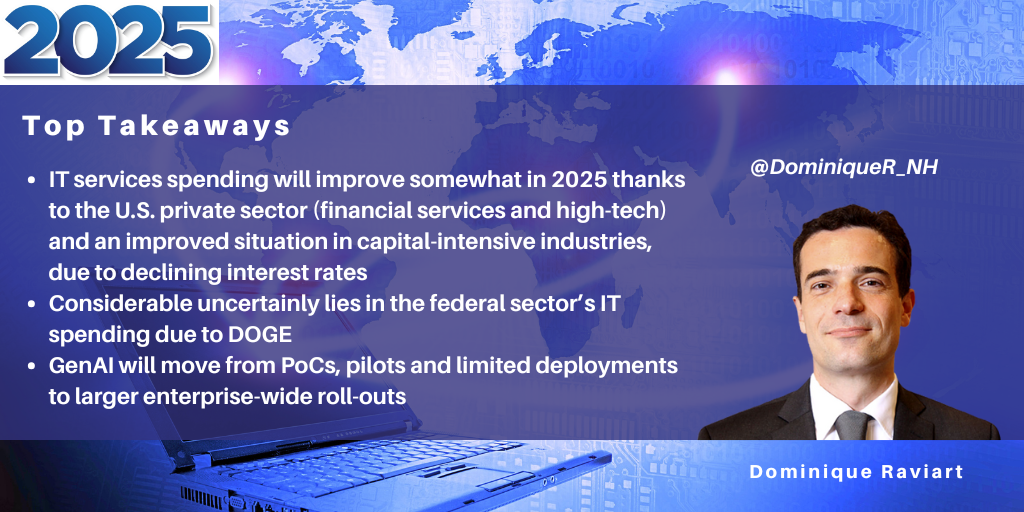posted on Jan 17, 2025 by Dominique Raviart

After the slowdown of 2023, 2024 promised to be the year of IT services reignition, particularly in the U.S. This scenario has not occurred. U.S. spending is only now on a recovery path in financial services and high-tech, with signs of improved discretionary spending.
We expect 2025 to be a reversal of recent trends, notably in U.S. IT services spending, having lagged Europe despite higher GDP growth in the U.S. We have passed this inflection point, and the U.S. private sector will gradually accelerate. However, considerable uncertainty continues in the federal sector, where massive public spending cuts are expected.
GenAI will continue to dominate the CxO agenda and materialize in more enterprise-wide programs this year. GenAI consulting is becoming a must-have to help clients navigate the complexities of the models. Similarly, expect the same digital adoption patterns with security, SaaS applications, cloud migration, and some sustainability consulting activity.
Rebound in the U.S. Private Sector
2025 will be a year of a gradual rebound in the U.S., led by the private sector, despite continuing high interest rates that will impact capital-intensive industries such as telecom and energy & utilities. Financial services will continue to rebound, and high-tech will start, too. Consumer goods and retail will improve, partly reflecting the low unemployment level in the country. Automotive will continue to suffer.
Across sectors, discretionary spending will rise, driven by innovation, while IT outsourcing contracts/managed services programs will continue to focus on large transformations and savings initiatives.
A significant uncertainty lies in how decisions made by the newly-created Department of Government Efficiency (DOGE) will impact the federal government and healthcare sectors. Advisors Musk and Ramaswamy have ambitious cost-saving goals (targeting $0.5-2.0tn out of $6.75tn in federal spending): those ambitions will only indirectly impact IT spending as DOGE consolidates agencies and/or tackles programs such as Medicaid. The impact on the U.S. federal IT spending ($122bn in FY23) will be real but cannot be sized yet.
U.K./Europe Mixed
The situation in the U.K. private sector will improve (based on 2025 GDP projections from the IMF). However, the slowdown in Europe will continue, where there are cracks across industries and geographies, in particular in:
- Germany, with the manufacturing sector and the Mittelstadt impacted by slowing demand from China (e.g., industrial equipment) and Chinese competition (e.g., automotive)
- France, due to the political instability, affecting business confidence and the new government cutting public sector spending on the back of a higher-than-expected deficit.
More GenAI Deployments
Across sectors, GenAI will accelerate its move from PoCs, pilots, and limited deployments to larger enterprise-wide rollouts. Beyond the tremendous deployment opportunities, GenAI is a moving ground and requires advisory services that are:
- Technical (which LLMs to use, open-source vs. COTS, SLMs vs. LLMs, how to make ML and GenAI coexist and complement each other)
- Business-led (e.g., FinOps).
Clients have experimented with LLMs to understand what they could deliver in a typical greenfield scenario (without considering whatever development and testing assets clients have). They now need to combine LLM output and their existing assets (whether objects and standard LoCs/features for their development projects or test cases and scripts in QE) under a brownfield approach and finetune/improve the clients’ assets.
Expect to see the market explore:
- How to combine traditional AI (largely ML, but also DL, NLP, and computer vision) and LLMs
- Multi-LLM agent scenarios. The first use case will be one GenAI model executing a task and another one QCing the output
- Lower costs and consumption, with NVIDIA and also partnering with competitors, moving away from NVIDIA’s high costs. Expect vendors to lower computing costs using specialized agents relying on small language models
- Elaborate vertical-specific GenAI use cases.
We are not seeing an impact of GenAI on pricing models. We expect organizations will continue to procure GenAI projects on T&M or fixed price schemes despite the intention of several vendors to sell them under a consumption model. Nevertheless, clients and vendors will work on FinOps for GenAI to limit consumption and set up governance guidelines.
Demand for graduate recruitment is an area that GenAI may impact, with low-value activities replaced by GenAI-based automation. Currently, we are seeing developers and testers in application services using GenAI to enhance their productivity, but they are not being replaced. GenAI does, however, threaten the IT services business model, which has tended to rely on an age pyramid with a broad base. With GenAI, we will see an age pyramid steeper than in the past. We will not see a ‘diamond-shaped’ pyramid that would unbalance the delivery cost for most IT service vendors.
More of the Same in Digital
Outside of AI, we expect continued strong growth in cybersecurity, digital (i.e., front office and SaaS applications), migration of applications to the cloud, and adoption of SAP S/4HANA. Consulting, including UX, will be up in the U.S., while Europe will continue to invest in sustainability, consulting, and the circular economy, indirectly impacting suppliers in APAC.
Outside of IT services, in ER&D, connected devices will pick up again thanks to the high-tech sector. We expect limited momentum in AR/VR/metaverse and blockchain. Industrial IoT services spending will slow down in Europe.
2025 Will Be A Mixed Year
Acceleration in the U.S. private sector is a given. Uncertainty rules in U.S. federal. And overall, U.K./Europe will slow down. In this mixed economic environment, GenAI will lead demand across geographies and sectors, with enterprise-wide deployments starting to happen. Against expectations, 2025 will not be the year we see a significant return to discretionary spending. Managed services/IT outsourcing will continue to be prioritized in client budgets. Expect higher spending in 2025 than in 2024, albeit in an environment of continuing uncertainties.
